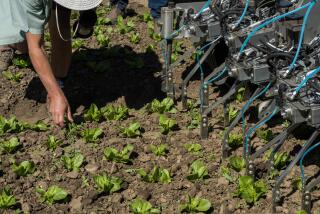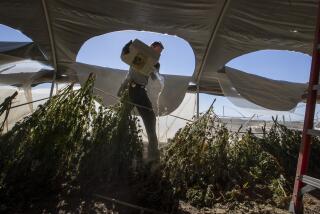Veteran Emerald Triangle pot growers see their way of life ending
LAYTONVILLE, CALIF. — In the mountains of Mendocino County, a middle-aged couple stroll into the cool morning air to plant the year’s crop. Andrew grabs a shovel and begins to dig up rich black garden beds while Anna waters the seedlings, beginning a hallowed annual ritual here in marijuana’s Emerald Triangle.
In the past, planting day was a time of great expectations, maybe for a vacation in Hawaii or Mexico during the rainy months or a new motor home to make deliveries around the country.
But this year, Andrew and Anna are hoping only that their 50 or so marijuana plants will cover the bills. Since the mid-1990s, the price of outdoor-grown marijuana has plummeted from more than $5,000 a pound to less than $2,000, and even as low as $800.
Battered by competition from indoor cultivators around the state and industrial-size operations that have invaded the North Coast counties, many of the small-time pot farmers who created the Emerald Triangle fear that their way of life of the last 40 years is coming to an end.
Their once-quiet communities, with their back-to-nature ethos, are being overrun by outsiders carving massive farms out of the forest. Robberies are commonplace now, and the mountains reverberate with the sounds of chain saws and heavy equipment.
“Every night we hear helicopters now,” Anna said. “It’s people moving big greenhouses and generators into the mountains.”
Andrew, 56, and Anna, 52, who agreed to be interviewed only if they would be identified by their middle names, live in a rambling house down a trail through tanoaks and Douglas firs. Their electricity comes from a windmill and solar panels, their water from a spring. They cook on a wood stove and use an outhouse with a composting toilet to conserve water for their crop.
Though they are not complete back-to-the-landers — they have a nice car, satellite TV and Internet access — they keep their gardens relatively small, tucked in the trees throughout their property.
Among their plants, they post their own medical marijuana cards so that if they’re raided, it looks as though they’re growing under the aegis of state law. But because dispensaries generally prefer the more potent weed grown indoors, they still sell mostly to the black market, where mom-and-pop growers now struggle to compete.
“These big commercial growers have really ruined our business,” Anna said.
Until recently, life in the hills of Mendocino and Humboldt counties had changed little in the decades since hippies from the Bay Area began homesteading here. The pioneers initially grew marijuana for themselves and to make a little money.
Then in the 1980s, cultivation of high-grade seedless marijuana opened the possibility for big money as it brought a higher premium. Many of the farmers cashed in. But many remained small and discreet to avoid attracting the attention of state and federal agents.
They raised their families where they cultivated. They drove beat-up Subarus and small Toyota pickups, pumped their water from wells and chopped their own firewood.
The mountain hamlets operated like breakaway states. Marijuana farmers paid for community centers, fire departments, road maintenance and elementary schools.
Even today, small cannabis-funded volunteer fire stations and primary schools are scattered throughout the ranges. And the local radio station, KMUD, announces the sheriff’s deputies’ movements as part of its public service mandate.
But the liberalization of marijuana laws in the last decade upended the status quo.
From Oakland to the Inland Empire, people began cultivating indoors on an unprecedented scale at the same time that growers from around the world flooded the North Coast because of its remoteness and deep-rooted counterculture.
Now, with the market glutted, people are simply planting ever-larger crops to make up for the drop in price.
Longtime residents complain that the newcomers cut down trees, grade hillsides, divert creeks to irrigate multi-thousand-plant crops, use heavy pesticides and rat poisons, and run giant, smog-belching diesel generators to illuminate indoor grows. They blaze around in Dodge monster trucks and Cadillac Escalades and don’t contribute to upkeep of the roads or schools.
“They just don’t care,” said Kym Kemp, a teacher and blogger in the mountains of Sohum, as locals call southern Humboldt County. “They’re not thinking, ‘I want my kids to grow up here.’
“Now there are greenhouses the size of a football field that weren’t even there last year,” she added.
Kemp said she feels her region is being colonized and worries about the colorful, off-the-grid people that small cannabis patches long supported.
“So many people who live here are just different,” she said. “They don’t fit in regular society. They couldn’t work 9-to-5 jobs. But they’ve gotten used to raising their kids on middle-class incomes. What are they going to do?”
Tom Evans, 61, a small-time grower in northern Mendocino, said the sense of peace and self-reliance he moved here for 30 years ago is disappearing so fast that he may leave for Mexico.
“It used to be a contest to see who could drive the oldest pickup truck,” said Evans, a former Army helicopter mechanic who sports a woolly gray beard and tie-dyed shirt. “There’s just been this huge influx of folks who have money on their mind, instead of love of the land. A lot more gun-toters. A lot more attack dogs.”
Evans lives in a small rented home that generously could be called a fixer-upper. He said he doesn’t have a bank account or credit card, and his Honda Passport has more than 300,000 miles. “It’s ‘make a living, not a killing,’” he said.
His friend, a bear of man who goes by the name Mr. Fuzzy, noted that it’s not only outsiders causing problems.
“You know the weird part, these are our kids too,” he said.
It’s a recurring lament among longtime growers. Some of their own children are going for the large-scale grows, big money and fancy cars.
The larger irony is that the marijuana pioneers are being pushed to the margins by the legalization they long espoused.
“Ultimately we worry about Winston or Marlboro getting some land and doing their thing,” said Lawrence Ringo, a 55-year-old grower and seed breeder deep in the wilds of Sohum. “We see it time after time in America — big corporations come in and take over.”
Ringo saw the 2010 marijuana initiative, Proposition 19, as a ploy by Bay Area activists to dominate the market with giant warehouse grows in Oakland.
He suspects plenty of people will still want high-quality, organically grown cannabis but fears the big business interests will dictate how marijuana gets regulated. Ringo points out that Colorado, the one state that fully regulates marijuana, helped push most growing indoors and place cultivation under the control of large dispensaries.
“We’re afraid of losing what we’ve been doing for 40 years,” he said.
As competition drives prices down, even chamber of commerce types acknowledge that the North Coast economy is at risk. Pot kept things afloat as the logging and fishing industries declined. Restaurants, car dealerships, banks, hotels and dental clinics all depend on marijuana money.
“There’s probably not one business that doesn’t benefit,” said Julie Fulkerson, who founded a home furnishings store and comes from a prominent third-generation Humboldt family.
Walk into the upscale Cecil’s New Orleans Bistro in small-town Garberville and you’ll find growers in dirty T-shirts unpeeling rolls of $20 bills to pay for martinis and $38 steaks. More soil supply and hydroponics shops line stretches of Highway 101 than gas stations, and trucks laden with bags of soil and fertilizer kick up dust as they make deliveries on the most isolated roads.
During harvest, hardware stores put out huge bins of Fiskars pruning scissors, the preferred tool for marijuana trimmers. Safeway stocks so many turkey bags that an outsider might wonder how such small locales could consume so many birds. The sealable, smell-proof bags are used for storing and transporting weed.
“I wouldn’t survive … if it wasn’t for growing,” said Tom Ochner, 54, who runs a country store and rental cabins outside of Covelo — a business called the Black Butte River Ranch. “Owners realize this is what makes their business go.”
Concerned about the economics of legalization, Humboldt banker Jennifer Budwig studied the amount of pot money entering the local economy.
Using an extremely high estimate that law enforcement seized 25% of the total amount of pot grown in Humboldt, she found that the crop generated at least $1 billion a year — of which $415 million was spent in the county. She said the actual figure could be several times higher.
Legalization “has the potential to be devastating,” she said.
Some small growers, like Anna and Andrew, still hold out hope that they can beat back the deluge of industrial marijuana.
There’s a market, they say, for sun-grown weed among discerning users who appreciate the nuances of regional variety.
A grower just down the road said he hoped to start promoting “Mendocino terroir.”
“How can sun-grown not be better medicine?” Anna asked. “If you’re sick, you want something that has chemicals in it? You can’t grow indoor organically. Not to mention the fossil fuels it burns up.”
But even if boutique weed has some potential, the couple still sense that their life in the mountains is changing for good. The next-door neighbor recently had a home-invasion robbery, and a young man down the road was shot in the face during a deal.
Andrew goes back to planting the new crop. He used to have the radio on all day — something to engage his mind during the tedious work.
He doesn’t anymore.
He keeps it quiet, listening for intruders.
twitter: @joemozingo
More to Read
Sign up for Essential California
The most important California stories and recommendations in your inbox every morning.
You may occasionally receive promotional content from the Los Angeles Times.










